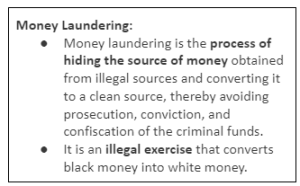Context:

FATF is looking to revise its current recommendations aimed at safeguarding non-profit organizations (NPO) from being abused for terrorist financing.
| PYQ:
Q. Discuss how emerging technologies and globalisation contribute to money laundering. Elaborate measures to tackle the problem of money laundering both at national and international levels. (2021) |
More on News:
About Financial Action Task Force (FATF):
Function of FATF:
Classification of Countries by FATF:
Consequences of being in the FATF’s list:
Challenges Associated with FATF:
FATF and India’s Legal and Institutional Frameworks:
Way Forward:
News Source : The Hindu
| Manas National Park | The recent All India Tiger Estimation 2022 revealed Manas National Park’s shift to high tiger density in western Assam, However, a substantial challenge is posed by a staffing deficiency of approximately 63%.
About Manas Tiger Reserve:
|
| Clouded Leopards | Researchers from the Wildlife Institute of India (WII) have observed a peculiar behavior among clouded leopards within Manas National Park and Tiger Reserve in western Assam.
About Clouded Leopard:
|
| BRICS Health Minister’s Meeting | Recently, the Union Minister of Health and Family Welfare addressed the virtual BRICS Health Minister’s Meeting.
|
| Project Devika | Recently, the Union Minister of State (Independent Charge) for Science & Technology; stated that North India’s inaugural River Rejuvenation Project, Devika, is nearing its completion.
About Devika Project:
Devika River: It originates from the hilly Suddha Mahadev temple in Udhampur district of Jammu and Kashmir and flows down towards western Punjab (now in Pakistan) where it merges with the Ravi river. |
| Subramania Bharathi | Recently the President Droupadi Murmu unveiled a portrait of nationalist Tamil poet-journalist Subramania Bharathi at the Raj Bhavan.
About Subramania Bharathi:
|
Context:
Recently, the World Trade Organization (WTO) unveiled its annual flagship publication, the World Trade Statistical Review (WTSR) for 2023.
Highlights From World Trade Statistical Review (WTSR)
About World Trade Statistical Review (WTSR) 2023:
News Source: Business Standard
Context:
The Zoological Survey of India (ZSI) recently published a report titled “75 Endemic Birds of India,” to commemorate the 108th anniversary of the foundation of the ZSI.
Key Findings of the Report:
About Zoological Survey of India:
|
News Source: The Hindu
Context:
Recently, the Union Cabinet approved Rs 1.39 lakh crore for modernising the BharatNet project.
Tweaks in BharatNet Project Execution Strategy:
Role and Contribution of Village Level Entrepreneurs (Udyamis):
About Bharatnet Project:
News Source: The Indian Express
Context:
What are Nuclear weapons?
Difference between an atomic bomb and hydrogen bomb:
Development and proliferation of Nuclear bombs:
Nuclear Fission:
Nuclear Enrichment:
|

Fig. Timeline of nuclear weapons tests
Image Source:ucsusa.org
Nuclear Program of India:
India’s three-stage nuclear power programme:
 Natural uranium fuelled Pressurized Heavy Water Reactors (PWHR): It uses natural uranium to fuel PWHR to produce electricity and produces plutonium-239 as a byproduct. While PWHR used unenriched uranium, Light Water Reactors required enriched uranium.
Natural uranium fuelled Pressurized Heavy Water Reactors (PWHR): It uses natural uranium to fuel PWHR to produce electricity and produces plutonium-239 as a byproduct. While PWHR used unenriched uranium, Light Water Reactors required enriched uranium. Nuclear Doctrine of India:
The Nuclear non-proliferation regime:
Pillars of the treaty:
Emerging Challenges to Nuclear Deterrence:
Way Forward:
News Source: Indian Express
SC Verdict on Newsclick Shows Adherence to Due Pro...
Stay Invested: On Chabahar and India-Iran Relation...
Credit Rating Agencies, Impact on India’s De...
Catapulting Indian Biopharma Industry
Globalisation Under Threat, US Import Tariffs Have...
Global Report on Hypertension, Global Insights and...
<div class="new-fform">
</div>
